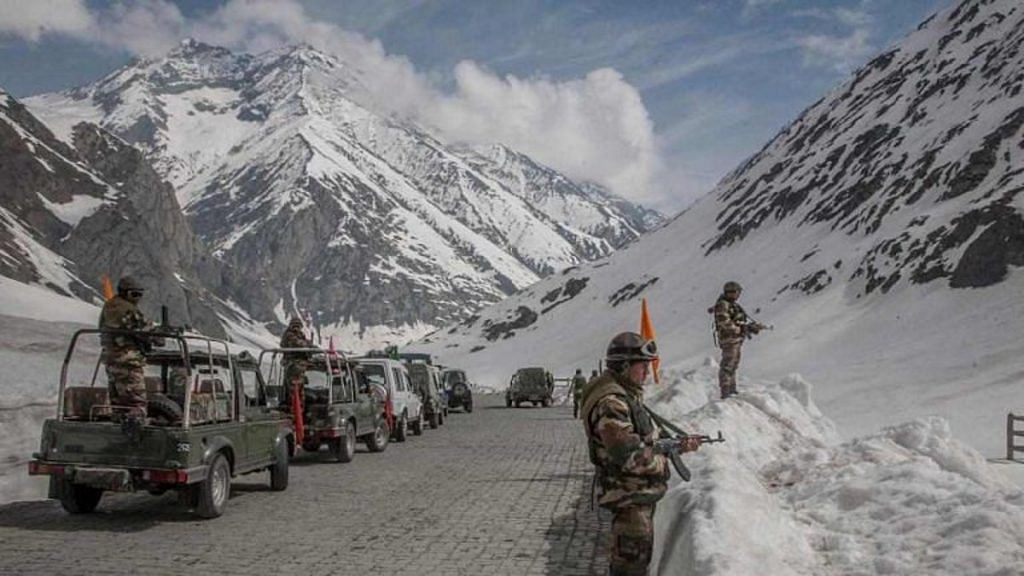New Delhi: The 14th round of military talks between India and China Wednesday failed to immediately break the logjam over disengagement in the Hot Springs area in eastern Ladakh. However, a broad understanding on it has been reached between the two sides after what has been termed as “constructive talks”, ThePrint has learnt.
The next round of talks will be held soon to work out the disengagement at Hot Springs after both sides get the necessary political directives for the understanding reached Wednesday, sources in the defence and security establishment said.
Sources said the latest round of talks, held on the Chinese side of the Chushul-Moldo meeting point, began at about 10 am and ended around 10.30 pm.
The Indian delegation, led by the new 14 Corps Commander Lieutenant General Anindya Sengupta, gave a detailed opening statement and presented its proposals, the sources added. The People’s Liberation Army, led by south Xinjiang military district chief Major General Yang Lin, also made a short statement and discussions ensued.
While disengagement at Patrol Point 15, which is also known as Hot Springs, was the main agenda, the Indian side also raised the issues of Depsang and Demchok which are seen as “legacy issues”, sources said.
The issue of restoration of patrolling in the buffer zones created at past disengagement points was also taken up, sources said.
The Chinese side said it will get back soon after speaking at the higher level, they added.
“While this talk has failed to make any immediate breakthrough as far as disengagement at Hot Springs is concerned, this round was not a failure also. It was constructive. The Chinese were receptive to our suggestions and they had their own points as well. The issue of Hot Springs will most likely be sorted out in the next round,” a source said.
However, a second source said there is a lot of “trust deficit” between the two sides and further discussions will take place within their own circle of decision-makers.
In a joint statement released by India and China Thursday evening, the two sides said they had a frank and in-depth exchange of views for the resolution of relevant issues along the LAC in the western sector.
“They agreed that both sides should follow the guidance provided by the state leaders and work for the resolution of the remaining issues at the earliest,” the statement said, adding that it was noted that this would help in restoration of peace and tranquility along the LAC in the western sector and enable progress in bilateral relations.
“The two sides also agreed to consolidate on the previous outcomes and take effective efforts to maintain the security and stability on the ground in the western sector including during winter.”
According to the statement, the two sides “agreed to stay in close contact and maintain dialogue via military and diplomatic channels and work out a mutually acceptable resolution of the remaining issues at the earliest”.
“In this context it was also agreed that the next round of the commanders’ talks should be held at the earliest,” the statement said.
Also read: Army chief says admission of women to NDA ‘not a big deal’, joint training has raised standards
Issue of Hot Springs
Currently, there are about 35-50 soldiers on each side in Hot Springs, the disengagement for which was first agreed upon in July 2020, immediately after the Galwan clash. However, while the Chinese did withdraw a large number of troops from the area, they retained a small group there, according to sources.
ThePrint Wednesday reported that Beijing is seeking to cement the current status quo, while New Delhi hopes for disengagement, and eventual de-escalation.
Sources had earlier told ThePrint that given the scale of build-up in infrastructure on both sides of the Line of Actual Control (LAC), practically, it is going to be “tough” to expect any side to go back to the April 2020 status, which was being sought initially.
In his annual press conference Wednesday, Army chief General M.M. Naravane said that while it is wrong to expect disengagement in every round of talks, he was hopeful of a forward movement on Patrol Point 15.
However, he also said that since the Chinese have developed a lot of infrastructure along the LAC and raised its troop deployment, “it remains to be seen whether they will permanently station them there or will be amenable for some de-induction for time to come”.
He had also made it clear that even though disengagement has happened at multiple friction points over the last year and half, the Chinese threat has “by no means reduced”.
This report has been updated with the joint statement issued Thursday evening by India and China on the 14th round of military talks
(Edited by Amit Upadhyaya)
Also read: Army resolved to show ‘zero tolerance’ towards terror, says General Naravane
